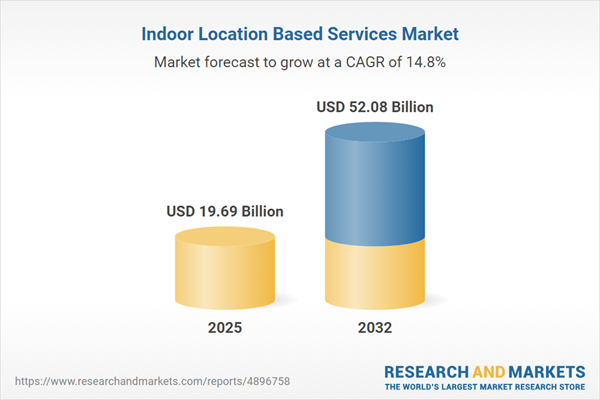Speak directly to the analyst to clarify any post sales queries you may have.
Indoor location based services are transforming the way enterprises manage facilities, assets, and operations by delivering real-time spatial intelligence and workflow optimization. As organizations seek to enhance agility amid shifting market conditions, these technologies are becoming integral to digital transformation strategies.
Market Snapshot: Indoor Location Based Services Market Overview
The global indoor location based services market is valued at USD 17.24 billion and is anticipated to expand at a compound annual growth rate (CAGR) of 14.81% through 2032. Growth in this sector is driven by increasing demand for operational transparency and advanced facility management. Enterprises across industries are implementing sophisticated positioning solutions that integrate IoT, real-time analytics, and automation. These investments enable organizations to optimize asset monitoring, automate scheduling, and coordinate operations in distributed and complex environments, aligning technology with evolving business requirements.
Scope & Segmentation of the Global Indoor Location Based Services Market
- Solution Types: Analytics platforms deliver actionable business insights. Campaign management and targeted outreach tools support precise internal communications. User-facing applications deepen engagement, while advertising and geo-targeting ensure contextually relevant marketing. Automotive navigation and facility automation streamline workflows. Transaction management platforms improve digital processes. Proximity technologies enhance workflow tracking and resource allocation, including beacon-enabled mapping for granular monitoring.
- Industry Verticals: These services support process optimization and operational visibility in automotive, financial services, healthcare, education, hospitality, tourism, manufacturing, retail, logistics, smart cities, sports, entertainment, and transportation environments, each with unique requirements and compliance considerations.
- Regional Coverage: Deployments are tailored to digital maturity and regulatory frameworks across the Americas, Europe, Asia-Pacific, the Middle East, and Africa. Key markets include the United States, Germany, China, India, Brazil, France, the United Kingdom, South Africa, the United Arab Emirates, and Australia, ensuring compatibility with local regulations and sector-specific demands.
- Technology Ecosystem: Wi-Fi triangulation, Bluetooth Low Energy beacons, ultra-wideband, and sensor fusion technologies are fundamental for real-time positioning. Edge computing and advanced AI algorithms improve data processing, while 5G and secure networking support scalable and reliable deployments for public and private sector facilities.
- Leading Providers: Apple Inc., Broadcom Inc., CenTrak, Cisco Systems, CommScope, Ericsson AB, Google LLC, HERE Global B.V., HID Global, Honeywell International, IndoorAtlas, Juniper Networks, Mapsted, Microsoft Corporation, Navigine, Nokia, Qualcomm, Siemens, SITUM TECHNOLOGIES, Sonitor Technologies, Trimble, Ubisense, and YOOSE Pte. Ltd. offer solutions that address specific industry and operational challenges.
Key Takeaways for Senior Decision-Makers
- Widespread adoption in sectors such as healthcare, warehousing, and retail enhances real-time tracking and maximizes asset and workforce utility across multiple facilities.
- Advanced analytics, including hybrid positioning systems, support compliance and risk management by improving responsiveness to regulatory shifts.
- Customizing solutions for logistics and manufacturing strengthens business reporting and facilitates close collaboration with external partners.
- Regional expertise is essential, as understanding local regulatory and compliance landscapes helps maintain business continuity in complex environments.
- Implementing integrated digital infrastructure increases the efficiency of centralized operations and supports seamless future technology upgrades.
- Engagement with sector-specialized vendors expedites adaptation to evolving enterprise needs and sustains innovation momentum across diverse industries.
Tariff Impact: Navigating Regulatory Influences on Indoor Localization
Recent changes in U.S. trade policy have led hardware providers to strengthen domestic manufacturing, improving resilience and stability in enterprise supply chains. Concurrently, software vendors are focusing on cloud-centric deployments to meet international compliance mandates and support scalable operations. Together, these approaches allow organizations to manage risk and adapt effectively within fluctuating regulatory landscapes.
Methodology & Data Sources
This report is built on insights from facility management, information technology, and marketing executives. All findings are benchmarked against established industry standards and compliance frameworks to ensure accuracy and actionable relevance for strategic planning.
Why This Report Matters for Senior Leaders
- Supports effective resource allocation, enhancing operational efficiency and business agility for organizations in digitally dynamic sectors.
- Offers actionable guidance for integrating indoor location based services, promoting sound governance and resilient digital infrastructure.
- Empowers executives to streamline operations by aligning technology strategy with long-term growth and competitive objectives.
Conclusion
Indoor location based services are essential for optimizing workflow transparency, spatial awareness, and cross-team coordination. By leveraging these solutions, organizations can confidently navigate changing business needs and pursue robust growth.
Additional Product Information:
- Purchase of this report includes 1 year online access with quarterly updates.
- This report can be updated on request. Please contact our Customer Experience team using the Ask a Question widget on our website.
Table of Contents
3. Executive Summary
4. Market Overview
7. Cumulative Impact of Artificial Intelligence 2025
List of Figures
Companies Mentioned
The companies profiled in this Indoor Location Based Services market report include:- Apple Inc.
- Broadcom Inc.
- CenTrak, Inc.
- Cisco Systems, Inc.
- CommScope, Inc.
- Ericsson AB
- Google LLC
- HERE Global B.V.
- HID Global Corporation
- Honeywell International Inc.
- IndoorAtlas Ltd.
- Juniper Networks, Inc.
- Mapsted Corporation
- Microsoft Corporation
- Navigine Corporation
- Nokia Corporation
- Qualcomm Incorporated
- Siemens AG
- SITUM TECHNOLOGIES, S.L.
- Sonitor Technologies
- Trimble Inc.
- Ubisense Limited
- YOOSE Pte. Ltd.
Table Information
| Report Attribute | Details |
|---|---|
| No. of Pages | 189 |
| Published | November 2025 |
| Forecast Period | 2025 - 2032 |
| Estimated Market Value ( USD | $ 19.69 Billion |
| Forecasted Market Value ( USD | $ 52.08 Billion |
| Compound Annual Growth Rate | 14.8% |
| Regions Covered | Global |
| No. of Companies Mentioned | 24 |









